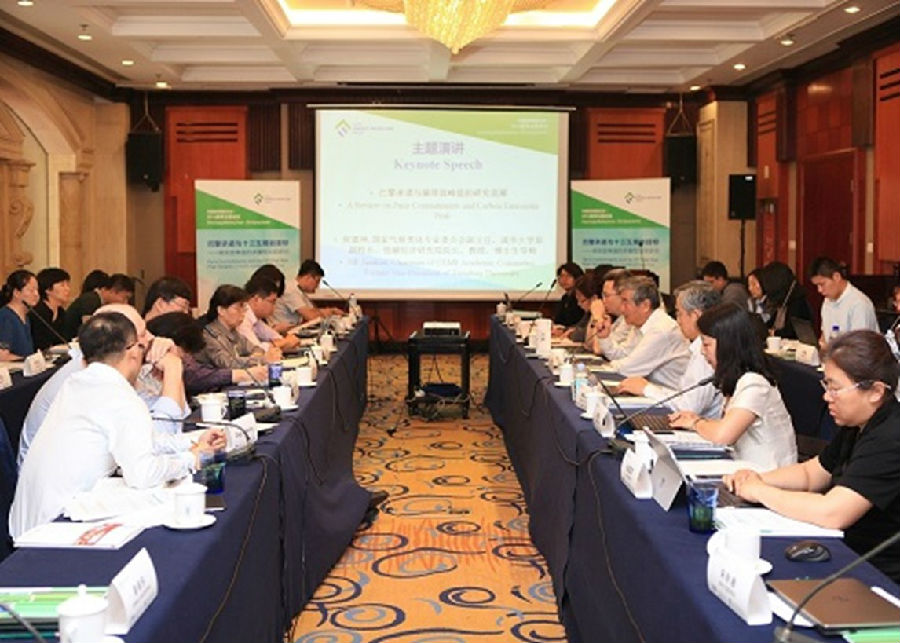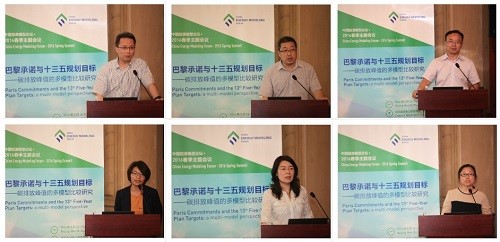The 2016 Spring Theme Conference of the China Energy Modeling Forum was held in Beijing on May 26-27, 2016. The CEMF project director, academic committee chairman and academic committee members attended the meeting. More than forty participants from the National Development and Reform Commission, the Ministry of Environmental Protection, the Ministry of Communications, the Development Research Center of the State Council, the Chinese Academy of Sciences and Tsinghua University, etc., around the theme of "Paris Agreement and the 13th Five-Year Plan Goals", each model team introduced For the peak carbon emission prediction of multiple industries, listen to expert comments and discuss with the guests, and gain new ideas in model improvement and scenario setting.。
On the morning of the 26th, Professor Xue Lan, director of the CEMF project and dean of the School of Public Policy and Management of Tsinghua University, delivered a welcome speech and announced the official start of the meeting. Dean Xue Lan suggested that through discussions at the China Energy Modeling Forum, it is necessary to strengthen the connection between energy and other fields, strengthen the relationship between industry energy model research and policy guidance, and promote energy models to better serve policy formulation. 。

Meeting Venue
The National Climate Change Strategy and International Cooperation Center introduced the use of the TIMES model to study the peak of carbon emissions in the power industry, the carbon market and carbon prices, and the pressure the power industry is facing under the requirements of low-carbon development. Discuss and design the setting of power demand, power supply constraints and technical parameters in the model, as well as the setting of carbon price and scenario.
The Environmental and Economic Policy Research Center of the Ministry of Environmental Protection respectively introduced the carbon emission predictions made by the transportation sector and the cement industry using the TIMES model. The traffic industry mainly involves road traffic. The model involves not only the transportation demand related to economic development, but also the adjustment of transportation energy types, the promotion of new energy vehicles and economic incentives. Forecasts for the cement industry have been recently updated, and the industry is not only concerned with energy consumption and greenhouse gas emissions, but also with pollutant emissions. Therefore, this model is used to analyze industry energy efficiency, dust removal and environmental protection technology, and cement demand forecast. At the same time, based on the scenario set by the Ministry of Environmental Protection for the coordinated control of greenhouse gas emissions and pollutant emissions, the cost of increase is relatively low and the effect is good. These are also the results obtained from the model.
The Policy Simulation Research Office of the National Information Center of the National Development and Reform Commission introduced the application of the TIMES model in the carbon emission prediction of the iron and steel sector. It mainly introduced the different carbon emissions in the production process of the iron and steel industry, the collection of various cost parameters, and analyzed the The impact of two major industry demands - construction and motor vehicles - on energy forecasting models for the steel industry. In the future, the model will be further improved to describe the marginal emission reduction curve of the steel industry to connect with the CGE model, and new production technologies will be continuously introduced into the existing open model.
The Institute of Energy, Environment and Economics of Tsinghua University introduced the TIMES model method to calculate different new energy storage technologies. Compared with the TIMES model of the power sector, the consideration of energy storage time periods is added, and the consideration of different energy storage time periods increases the complexity of the model. Dr. Oleg suggested using the Monte Carlo method in the model to simulate the range of energy generated by different new energy sources, so as to solve the problem of coverage probability of different new energy storage time periods.
China University of Mining and Technology (Beijing) introduced the establishment of an optimization model for the spatial layout of the coal industry. The optimization model takes the minimum cost (including coal conversion cost and transportation cost) as the optimization goal, and the constraints are natural resources (mainly water resources) and the environment (air pollutants, greenhouse gas emissions, land destruction, etc.). In addition to the setting of these parameters, the demand level of coal resources is also an important input affecting the model. Although this model is not a direct energy demand forecasting model, it involves the corresponding costs brought about by changes in energy demand and changes in environmental factors, and it also forms an example of the combination of energy forecasting model scenarios and results with other fields.
The Institute of Science and Technology Strategic Consulting of the Chinese Academy of Sciences introduced a top-down PIC model that provides the basis for the Sino-US Joint Statement 2030 Peak. The model adopts a simplified concept of general equilibrium. According to a basic scenario, different policy quantifications, it will bring national, provincial or industry-level policy impacts to the economic system, and output energy demand, emissions and economic impact. It is an example of combining energy models with policy simulations based on the previous research foundation of the Institute.
The Institute of Energy, Environment and Economics of Tsinghua University introduced the simulation of peak carbon emissions at the national and industry levels based on the MAPLE model. It mainly studies the benefits brought by the governance end of carbon emission reduction. Including the extent to which carbon emission reduction measures achieve emissions, and from the perspective of controlling pollution and achieving pollution control goals, four scenarios are jointly formed, and their benefits are analyzed. It will be further refined in the future, including water supply and impact on power system vulnerability.
The Policy Simulation Research Office of the National Information Center of the National Development and Reform Commission introduced the carbon emission peak path selection based on the SICGE model. On the basis of the traditional CGE model, this model expands the economic sector, subdivides the products of the agricultural and energy sectors, and adds some non-market factors. It also increases the research on the carbon market and carbon price, bringing energy Changes in Product Usage. The model can be used to estimate the impact of different carbon emission scenarios on the macro economy.


